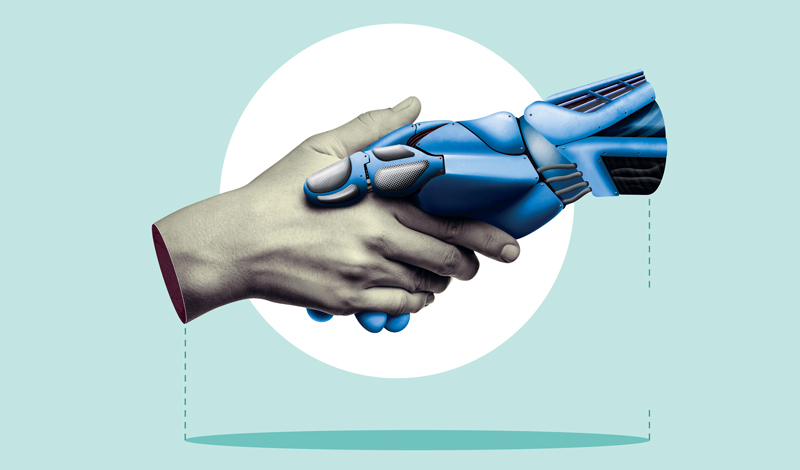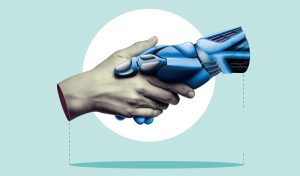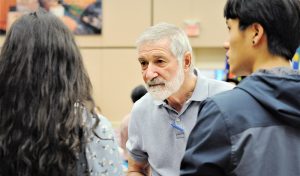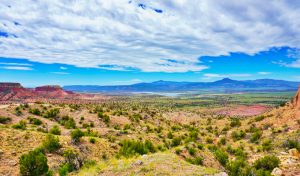On July 16, 1945, the atomic age came into being when scientists detonated the first atomic bomb in the New Mexico desert. J. Robert Oppenheimer, the director of the Manhattan Project, would later recall in a magazine profile the reactions of those present: some laughed, some cried, most were silent. In his own mind ran a line from the Hindu scripture Bhagavad Gita: “Now I am become death, destroyer of worlds.”
A month later, when the U.S. deployed atomic bombs over the Japanese cities of Hiroshima and Nagasaki, Oppenheimer became a vocal opponent of nuclear weapons and their horrific consequences, underscoring the moral dilemma that scientific progress would present in the nuclear age.
The fragile balance between humans and science is being upended again in the context of artificial intelligence (AI). In particular, as tools for generative artificial intelligence have become widely available in the past year, they’ve fueled a dizzying range of applications, from the helpful (“Siri, play my book”) to the value-creative (precision medicine that helps physicians tailor care for Alzheimer’s patients) to the destructive (a widely disseminated fake video of Ukrainian president Volodymyr Zelenskyy urging soldiers to lay down their arms amid active conflict). These represent the nascent applications of a technology that is already outpacing our ability to create ethical and legislative guardrails for it.
Amid this rapidly changing framework, what role can Buddhism play in finding a way forward?
In a society increasingly based on knowledge and information, we must develop the wisdom to master these resources.
Let us consider Ikeda Sensei’s address to the first graduating class of Soka University of America in May 2005, in which he spoke about the distinction between wisdom and knowledge. Citing the view of his own mentor, second Soka Gakkai President Josei Toda, who considered the confusion between the two as the “crucial misapprehension of contemporary civilization,”[1] he writes:
Knowledge alone cannot give rise to value. It is only when knowledge is guided by wisdom that value—defined by the father of Soka education, Tsunesaburo Makiguchi, as beauty, benefit and goodness—is created. The font of wisdom is found in the following elements: an overarching sense of purpose, a powerful sense of responsibility and, finally, the compassionate desire to contribute to the welfare of humankind. When wisdom arises from such wellsprings, it nourishes the kind of inner strength that remains unmoved by the superficial judgments of society and can acutely discern what is of genuine value and what is, in fact, detrimental.[2]
To be sure, Mr. Toda also stressed the importance of people being able to differentiate facts from truth, which he explains in The Human Revolution:
There is a difference between mere facts and the truth, though this may be difficult to comprehend. …
The facts as people perceive them do not necessarily represent the truth. For example, suppose there is a man who gives a great deal of money to the poor. His charitable act is an irrefutable fact, and from this some might conclude that he is a kind-hearted and generous individual. Yet this may not necessarily be true. His actions may have been calculated with the expectation of receiving some sort of future gain or advantage, or he may have done it to ingratiate himself with someone. …
In other words, facts don’t always reveal the truth. If we allow our eyes to focus exclusively on the facts, we may end up losing sight of the truth entirely.[3]
Sensei, in his address to the SUA graduates, goes on to consider what type of philosophy can guide this process of advancement in a manner that benefits humankind. We glean three points from that message.
No. 1—A philosophy of respect for life
At the time of SUA’s first commencement ceremony in 2005, Ikeda Sensei was carrying out an ongoing dialogue with Joseph Rotblat, a renowned physicist who became an ardent proponent of nuclear abolition. One of the topics they discussed at length was reverence for life.
Professor Rotblat had been born into a prosperous family in Warsaw, then Russian Poland, until the outbreak of World War I, when his family’s possessions were confiscated, and they fell into poverty.
It was this experience, indelibly imprinted on his young mind, that enabled him to act in accord with his convictions during World War II. He had joined the Manhattan Project (the research and development project that produced the first nuclear weapons) to counter the Nazi threat. However, when he learned that Germany had given up on its nuclear ambitions, he resigned from the project, the only scientist to do so before its completion.
Professor Rotblat became the focus of intense slander and rebuke as a result, yet he remained emboldened by the commitment that he made in his youth to use the power of science to create a world without war. Sensei writes:
Unless acted on, even the ideal of reverence for life can end up being a mere slogan without the power to transform reality. It must, therefore, be established as a genuine philosophy in our own hearts and in the hearts of others. We must put this philosophy into practice through concrete actions for peace, working one step at a time toward its realization.[4]
Each of us has the means to unlock the wisdom, courage and compassion necessary to create real, positive change. Our starting point is to chant Nam-myoho-renge-kyo and teach others of this Mystic Law, the fundamental rhythm that undergirds the universe.
Sensei has described the deep significance of chanting in this way:
The fundamental power activating and moving all stars, planets and other celestial bodies in the universe is Nam-myoho-renge-kyo. It is an incredible force. And we of the SGI embrace faith in this great Mystic Law. We chant the most powerful and supreme rhythm of Nam-myoho-renge-kyo. There is nothing stronger. Chanting is the key to absolute victory. We will never be defeated. When we practice as the Daishonin teaches, boundless energy and courage surge forth from the depths of our beings.[5]
When we call forth the Buddha nature within ourselves and those around us, we can stay true to our convictions and use our wisdom and spiritual strength to move society in the direction of respect for all life.
No. 2—A philosophy of respect for cultural differences
In his message to the SUA students, Ikeda Sensei described human history as being filled with conflicts derived from prejudice and misunderstanding of other cultures.
He then went on to relay a story about how deeply Gandhi’s philosophy of nonviolence had taken root in the minds of India’s youth at the time.
According to the late Dr. B. N. Pande, vice chairman of the Gandhi Memorial Hall, a mob of fanatical Hindus attacked a student hostel where both Hindu and Muslim students were living and working to complete their academic theses.
The mob said to the Hindu students that they would be safe if they came out of the hostel, leaving the Muslim students inside. If no one emerged, they would set fire to the building with everyone in it.
Yet, the Hindu students refused to come out until everyone’s safety had been guaranteed. In the process of this standoff, the army arrived to evacuate the students from the building.
The mob then insisted that only the Hindu students bring out their schoolwork and, yet again, they refused to do so. In the end, all the students exited safely, but the mob burned down the building with all their books and papers inside.
Sensei explains how Dr. Pande had spoken with one of the Hindu students, who had spent three years writing his doctoral thesis:
When he asked the student if he wasn’t bitter, the student responded: “What could I be bitter about? My conscience is perfectly clear. I acted in accordance with Gandhiji’s teachings. That is our spirit.” He had protected, to the very end, his fellow students whose religion was different from his own.[6]
Such tragic conflicts, derived from prejudice and misunderstanding, take on new dimensions when AI becomes advanced enough to amplify bias and discrimination. For that reason, at the heart of a philosophy that respects cultural differences lies the Buddhist principle of human revolution.
This process of inner transformation enables us to break through the shackles of our “lesser self,” bound by self-concern and the ego, and bring forth our “greater self,” which is capable of taking action and caring for others and, ultimately, all humanity. In the process, we can harness advancements in all spheres of human activity in a way that protects and serves humanity.
Sensei writes of the impact of such inner-directed change:
There are many kinds of revolutions—political, economic, industrial, scientific and artistic; there are revolutions in the distribution of goods and services, in communications, and in countless other spheres. Each is significant in its own way, and sometimes necessary. But whatever changes are made, if the people implementing them are selfish and lack compassion, they won’t improve the world. Human revolution is the most fundamental revolution and, indeed, the most essential revolution for humankind.[7]
No. 3—A philosophy rooted in the shared vow of mentor and disciple
In the Lotus Sutra, the Buddha expresses the following determination: “At the start I took a vow, hoping to make all persons equal to me, without any distinction between us.”[8]
The spirit of shared commitment between teacher and learner, mentor and disciple, is the basis for continually developing our humanity and returning to the spirit to place the happiness of people at the center of all human activity.
Sensei explains:
Just as a diamond can only be polished by another diamond, it is only through intense human interaction engaging the entire personality that people can forge themselves, raising themselves up to ever greater heights. It is the relationship between teacher and learner, between mentor and disciple, that makes this possible. …
In terms of the essential capacities and possibilities of life, there is no inherent difference between teacher and learner. The mentor creatively and imaginatively uses various means and methods to inspire and awaken in the learner the wisdom and power that has been realized by the teacher. The true teacher, the mentor, desires nothing so much as to be equaled—no, to be exceeded and surpassed—by the students and disciples.[9]
When our activities are grounded in a spirit to repay our debts of gratitude to those who have supported our growth and a philosophy that prioritizes serving humanity, they become the prime point to which we can always return when faced with increasingly complex challenges in life and society. Sensei writes:
We are starting to recognize that people must come first and that human growth may be what is most important. We are coming to understand that, in our information-oriented societies with their explosion of knowledge, we urgently need a matching explosion of wisdom to use that knowledge properly.[10]
While science and technology have indeed provided invaluable benefits to our lives and health, they can also be the impetus to distance ourselves from our surroundings and, even worse, objectify and reduce everything around us to numbers and objects.
This is personified by the development in several countries of Lethal Autonomous Weapons Systems (LAWS), also known as killer robots, which can take out a target without any ethical dilemma involved. The Campaign to Stop Killer Robots, a civil society coalition of which the SGI became a member in 2018, is working to ban the development and use of LAWS.
Sensei writes of this effort: “I have been warning of the threat they present from a humanitarian and ethical perspective because these weapons, when given a command to attack, automatically go on killing with no hesitation or pangs of conscience.”[11]
While knowledge can be transmitted from one person to another, the only way to develop wisdom is to acquire it through personal experience. What then should be our viewpoint in developing our lives and societies in the 21st century? Sensei writes:
Of course, it is ideal to possess both wisdom and knowledge, but everything ultimately depends on wisdom. Our goal is happiness, and happiness cannot be attained through knowledge alone. The only way to realize true human happiness and prosperity in the 21st century, therefore, is to make it a century of wisdom.[12]
The goal of SGI’s kosen-rufu movement is precisely this.
It is our mission as Soka Gakkai members to spread widely such Buddhist principles as respect for life, unity in diversity, human revolution and a spirit to work for the benefit and well-being of the people. We can find no other time in our history when people are yearning for the wisdom to do so.
We can look to the writings and actions of Nichiren Daishonin and the three founding Soka Gakkai presidents as a finely tuned roadmap to how to become unshakable, how to maintain our composure and persistence in the face of the headwinds that we will inevitably come up against in bringing about an era of peace. In that sense, AI and any other technologies developed in the future are neither positive nor negative in and of themselves. It’s what we, as human beings, believe in, practice and protect that will ultimately guide them.
—Prepared by the Living Buddhism staff
References
- www.daisakuikeda.org/sub/resources/works/lect/lect-10.html. <accessed on August 22, 2023> ↩︎
- Ibid. ↩︎
- The Human Revolution, p. 1722. ↩︎
- www.daisakuikeda.org/sub/resources/works/lect/lect-10.html <accessed on August 22, 2023>. ↩︎
- February 12, 2010, World Tribune, p. 5. ↩︎
- www.daisakuikeda.org/sub/resources/works/lect/lect-10.html <accessed on August 22, 2023>. ↩︎
- The Wisdom for Creating Happiness and Peace, part 2, revised edition, pp. 6–7. ↩︎
- The Lotus Sutra and Its Opening and Closing Sutras, p. 70. ↩︎
- www.daisakuikeda.org/sub/resources/works/lect/lect-10.html <accessed on August 22, 2023>. ↩︎
- The Wisdom of the Lotus Sutra, vol. 1, p. 3. ↩︎
- May 10, 2019, World Tribune, p. 11. ↩︎
- The Wisdom of the Lotus Sutra, vol. 1, p. 15. ↩︎
You are reading {{ meterCount }} of {{ meterMax }} free premium articles





